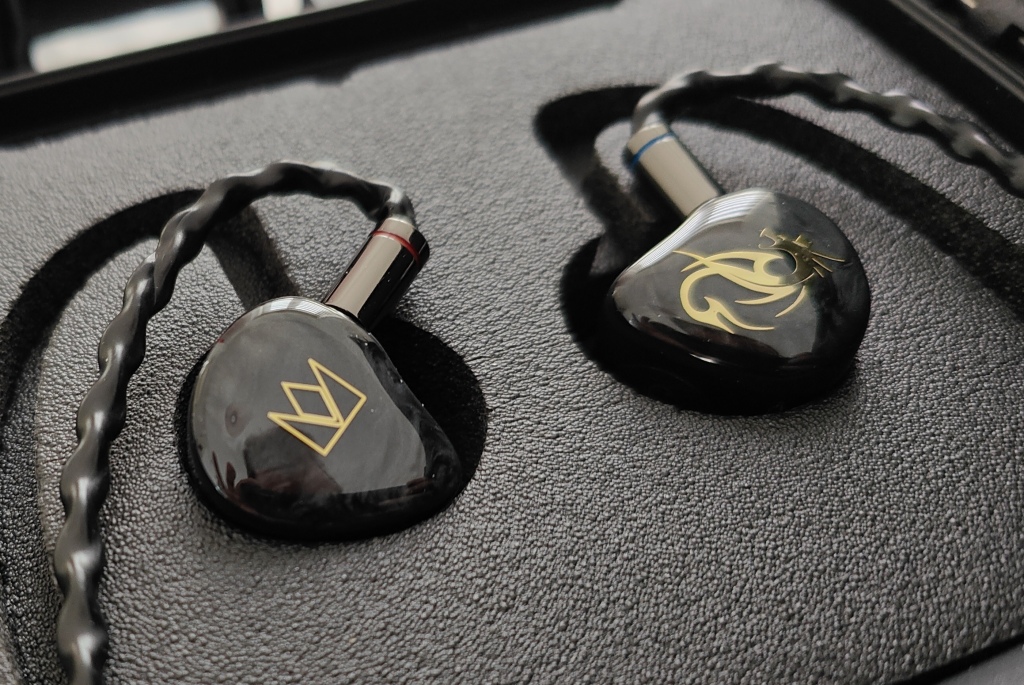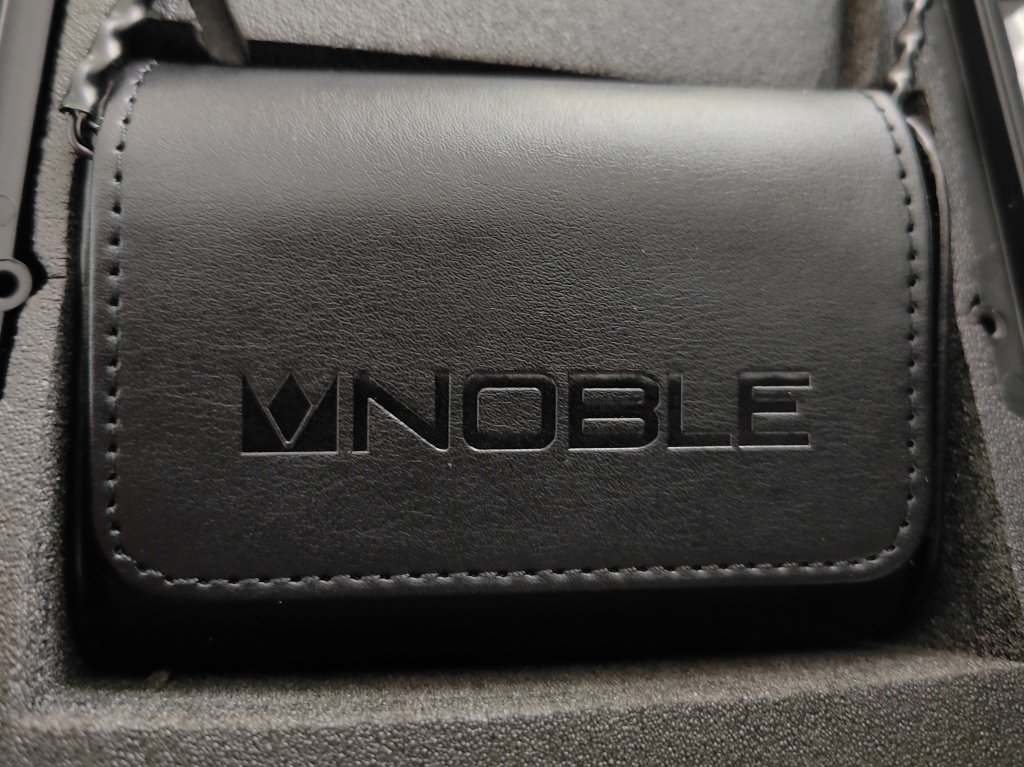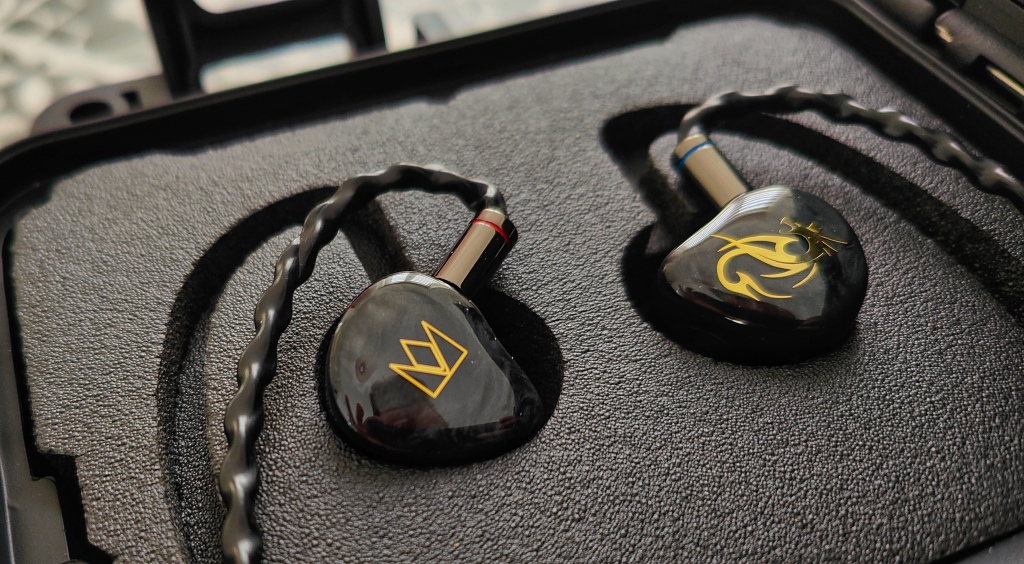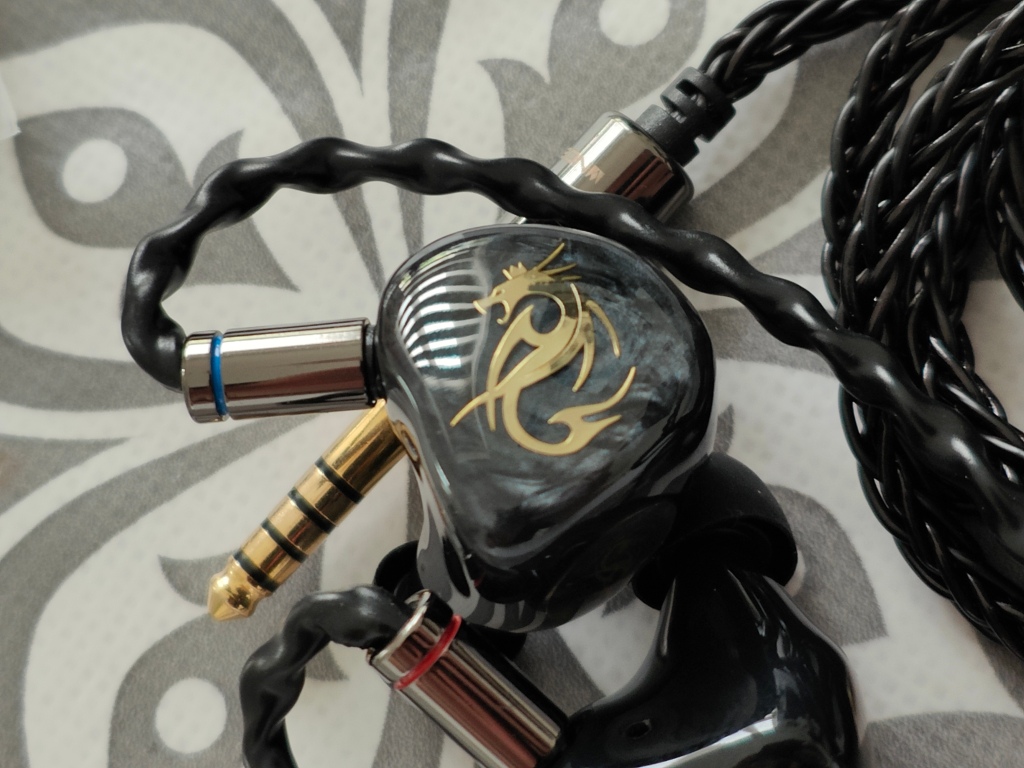
Acknowledgement
The Kublai Khan was purchased with my own money at a small discount from the ever-helpful Andrew at MusicTeck USA for the purposes of writing a full review (which will be published soon). No input or other incentive was sought or received from MusicTeck or Noble – all opinions and words below are my own (however ill-informed or misguided!). Many thanks to Andrew and the MusicTeck team for enabling me to hear these in-ear monitors, and for their excellent communication throughout the whole purchase process.
Link to Noble products currently available on MusicTeck can be found here .

Unboxing and accessories
The Kublai Khan comes in an external box that is nothing short of huge for an in-ear monitor. The initial package from UPS is big enough to hold an adult sized pair of basketball shoes, never mins a tiny in ear sound system. As boxes go, it’s simple but classy, with a nice graphic on the front, and the usual tech spec blurb on the back. Opening the initial cardboard rectangle gives you your first surprise though – the entire inner of the box is taken up with a black Nanuk 903 hard carrying case, emblazoned with the Noble logo. If you haven’t seen this sort of case before, it’s pretty reminiscent of the sort of seahorse cases that companies like ZMF and Audeze use to ship their high end over ear headphones.
In all honesty, on first glance, you almost think a pair of cans might be nestling in there. Taking the nuclear armageddon proof carry case out and clicking the two latches on each side to release the lid, you are presented with the IEMs themselves, sat in a custom cut foam inner, with a much smaller leather carry case of the IEMs (again emblazoned with the Noble logo) sat alongside. As far as unboxings go, this is more like opening a safe than a jewellery box, but there is an undeniable air of quality to the whole experience. T
The Nanuk case is probably more than you will ever need in terms of transporting these in-ears around safely, and is definitely less than practical in terms of the amount of storage space it takes up, but there is definitely something about knowing if you got run over by a tank while carrying your new IEM purchase in your hands, at least something would survive unscathed.
Accessories follow the standard Noble loadout, from what I can tell – a nice 8-wire braided cable (terminated in 4.4mm balanced in my case), a leather carry case, soft velour carry pouch, assorted ear tips (3 wide-bore silicone, 6 x memory foam) and cleaning tool, two wrist/amp stacking bands (black with a Noble logo) and the obligatory “Wizard” signature sticker. The cable is supple and feels quality, with a good weight to it (heavy enough to lay flat, light enough not to pull). Finish is worthy of an aftermarket cable, with matches metal splitter and Y-split and a nicely designed 4.4mm connector. The black PVC coating means this is more of a stealth design, and in a lot of ways this feels like a more pliable version of the M2 cable that unique Melody include with their MEST Mk2.
The other accessories are simple but should cover everything you need to get going – the leather looking carry case is quite light feeling so doesn’t scream quality (or sturdiness), but given the bulletproof nature of the parent case that’s hardly a huge drawback. Overall, the Kublai Khan package is pretty complete, with an outer case and cable giving that required touch of class that you would expect with a flagship-level product.

Tech specs
The Kublai Khan is technically a “quad-brid”, with a design that incorporates 7 drivers across four different driver types. Lows are shared between a 10mm dynamic driver (composition and design unknown) across the full range of low end frequencies and a similar sized bone conduction driver which is targeted more towards sub bass. The midrange is handled by four Knowles balanced armatures, and the treble is picked up by a new generation of the ceramic piezo driver used in the original Khan series.
Noble are notoriously sparse with their design specs, but it’s safe to say that their low entry bar for driving and power requirements remains in place – while the Kublai Khan appreciates cleaner power and more technically performant audio sources to really get the most out of its capabilities, you can probably blow your eardrums to bits using a 3.5mm iphone dongle adaptor. High powered sources are not a necessity here.

Build and fit
Given Noble’s history of producing some of the nicest “Prestige” builds in the industry, it’s hardly surprising to note that the Kublai Khan is a bit of a looker. Noble have opted for an acrylic body for these in ears rather than the all-metal designs of their previous K-series and co-flagship Sultan models. The design is simple but visually arresting, with a black lacquered shell in a pseudo-custom design, with a golden metal dragon of Asian descent sitting under the acrylic on one IEM shell, and the classic Noble crown logo in gold on the other. The dragon is visually stunning, and adds a really unique look to the IEM design. The other obvious visual highlight is the large 10mm bone conduction driver in each shell, which is clearly visible on the bottom side of each shell through the lacquer. In a nice bit of attention to detail, the outer shell of each BC driver has an engraved dragon logo (to match the larger gold design on the front).
Build-wise, the shells feel smooth and solid in the hand, with no obvious air bubbles or any other imperfections. The fit is perfect for my larger than average ear cavities – the Kublai Khan housing is pretty large so it does stick out a few mm from each ear when wearing (meaning these probably aren’t ideal for wearing when laying down, if you are a side sleeper), but the casual ergonomics are pretty much bang on for my own ears. I get a very good seal with the included wide bore silicone tips, and can wear the KK for extended listening sessions without any discomfort due to the lightness of the cable and IEMs themselves and the smoothness of the design. To be fair, you would expect a fairly famous manufacturer of custom in ears run by someone with a background in audiology to be on their game here, and they definitely are.
Given the use of bone conduction drivers, getting a fit where the maximum amount of IEM shell is in contact with the surface of your ear is paramount, so it’s nice to be able to achieve that straight out of the box without having to play around with the usual suspects like Spiral Dots or Xelastec tips. It’s even nicer for the IEM shells to feel comfy once you have got them in that “magic” position to maximise the BC elements of the sound.

Initial impressions on sound
*DISCLAIMER* These impressions are based on a solid fortnight of listening to the Kublai Khan through my main musical source (a Fiio M17) on medium gain. Please take them with the requisite metric tonne of salt – I’m stil getting used to the IEMs and the sound signature, so this is just an initial reaction to what I’m hearing out of the box. Also, these IEMs will probably still have less than 40 hours of play on them at time of writing, so if they change during burn in, I will document that in my follow-up review. If they don’t, I won’t.
My initial take on the Kublai Khan “sound” is that Noble have gone for something between musical and natural, This is an IEM with a good sense of balance – it’s too lush and rich sounding to call it strictly neutral, but there isn’t an overriding emphasis on any particular part of the frequency spectrum either. At a push, I’d say this is a classic but fairly gentle “W” shape, with a good low end heft, some prominent vocals and midrange instrumentation and a smooth but very capable treble. The “W” descriptor comes from the clever sculpting of the response around the bass/mids and mid/treble borders, which ensure nice clean transitions and no audible masking.

Bass
Bass is deep and very textured. The dynamic driver used actually sounds fairly fast to my ears, and has more of a focus on speed and resolution than sheer volume, so the KK low end isn’t hugely voluminous as a result. Don’t get me wrong, there is plenty of fat and chunky low end presence where the individual track requires it, but it definitely doesn’t step into basshead territory, more “basshead friendly”.
The bone conduction driver is supposedly targeted at the sub frequencies, and there is a palpable sense of physical rumble with these IEMs – I’m not sure if it’s just expectation bias or psycho acoustics at play, but you can definitely feel the thump on some tracks a lot more than you should be able to just going by the decibel output. It’s almost like you took a signature that’s just a few decibels off neutral in the low end, but replaced the “physical” slam and impact levels with something more usually associated with a much louder low end response.
Detail levels in the lows are high throughout, with the KK being able to resolve individual cello notes and bass guitar licks on complex symphonic or rock tracks without any undue effort, but without robbing them of a sense of weight. While it’s not hugely forward or overbearing, I think the bass on the Kublai Khan is very nicely judged in terms of hitting that Goldilocks zone where you get the musicality of a chunky bass presence without any of the bloating. It won’t give you the ultimate basshead high (or low), but it’s definitely packing enough in both quantity and quality to bring most genres of music to life.

Mids
If the bass is well judged, the midrange is where the KK really takes flight. The four balanced armatures combining together to give a midrange presentation that is both creamy but also ultra-resolving. This is where the Kublai Khan reveals its credentials as a top of the line monitor, with bags of resolution and clarity both in and around the notes. Vocals are forward, large in size and very emotive, accentuating the rasp of singers like Sister Hazel’s Ken Block without having to sharpen the edges of the image or bleed it of body. There is ample space and separation between the notes, with a slightly warm tonality illuminating the midrange instrumentation without making it sound stuffy or overly coloured.
Guitars have a nice sense of crunch and chug, going for a similar sort of organic tone that the recent JH Audio D.O.M.E. – powered models like the Lola and Jolene have made their trademark. There is just enough bite to the edge of the notes to avoid the KK sounding too fat or muddy, keeping the staccato speed of tracks like “Holy Wars” by Megadeth while also getting that nicely full guitar sound.
Vocals are the star of the show without a doubt, the Kublai Khan handling Elvis and Gregg Allman with equal care and attention and pouring plenty of emotion into their delivery. The singers are placed close to the listener on most tracks, slightly in front of the instrumentation. The width and depth of the stage stop them from feeling too intimate, giving the impression of being in the front row of a gig more than sat on top of a near-field speaker in the recording studio. Clarity and phrasing is exceptional, with the KK able to resolve the fine sounds as vocalist phrase each word. It feels almost ultra-HD, but oddly it isn’t distracting, being balanced out by the overall sense of emotional engagement. The Khan v2 can certainly hit you with midrange detail, but it makes sure to do it with heart. It’s a nice balance.
Timbre is another highlight on the Kublai Khan, with piano and acoustic guitar tracks both benefitting from the richness of the tone to sound lifelike. Noble have gone for an overall tone that evokes the old Final Audio Design flagship models, with a sense of emotional rawness almost at odds with the weight and density of the notes.

Treble
The treble transition is again smoothly handled, with the KK showing a good level of coherence. The ceramic piezo tweeter is technology I’ve heard before (albeit a previous generation) on the IMR Acoustics series of in-ears, and Noble have definitely taken the bar and raised it in terms of what this particular driver tech is capable of. Tone-wise, it straddles the border between high quality BA treble (with the attendant bite and sharpness) and that more smooth and effortless sort of ethereality that the newer second-gen EST drivers from Sonion are capable of. It’s a very good compromise between the two, carrying plenty of crispness and bite but without harshness or glare. The piezo givesthe treble a rounded density that feels like it polishes the raw edges out and just leaves the detail behind.
It’s also a quick treble driver, handling guitar harmonics and other transients without blinking or blurring. I’ve tried plenty of tracks on the Kublai Khan that are busier than downtown Tokyo in rush hour, and nothing got close to congesting the stage. “Starlight” by Slash and Myles Kennedy is a mess of high-pitched dissonance and harmonics in the intro, and the KK brings that to life for the listener without scratching the eardrums. It handles Kennedy’s falsetto equally well, not reaching into sibilance or harshness territory, which is easily enough done on this track with the wrong gear.
Listening to some more laid back tracks, “Chi Mai” by Duel sounds emotive, with the twin violins in the foreground sounding rich and vibrant but not too loud or forward on the stage. The swirling keys in the background don’t get overpowered by the strings, and float around the large stage filling in the space around the musicians. If I’m honest, it’s probably the best rendition of this particular track that I’ve heard with the various gear I’ve reviewed. I heard the original Khan at Canjam London a few years back and the treble on that IEM was definitely not to my taste, leaving an impression of being technically capable but too hot and thin for my personal preferences. Fast forward to the new iteration, and Noble have kept the extension and technicalities that the piezo driver is able to produce but toned down the overall volume and “heat” to create something far more balanced and polished, not to mention more tonally accurate.
Cymbals are crisp but not the most splashy, erring more towards real than emphasised. Decay is quick, hi-hats muting quickly into the background rather than echoing. It suits the overall sound choice, but if you like your treble spicier than a Carolina Reaper and splashier than a Spring Break pool party, you’re probably better off looking elsewhere.

Technicalities
The Kublai Khan casts a wide and deep stage, placing you at the front of the stage area with music spreading out wide outside the ears in both direction and almost surrounding you on some tracks. It shares some of the holographic traits of the MEST Mk2 and the bone conduction models from IMR, with the addition of the BC driver allowing for that little extra splash of “realism” that makes the music feel a little more dimensional in the ear.
Separation and layering is very good, as you would expect from a monitor in this price bracket. The space between the notes is most apparent in the midrange, with the KK doing an excellent job of separating individual singers in gospel chorus-lines but without dissecting them or losing the connection to the music.
Height is also a notable point on the Kublai Khan, the larger than average note size helping in this regard. I have the uncanny feel on “Bad At Love” by Smith and Myers that the percussion playing about two thirds of the way through the track is sitting below and to the right and left of my head rather than on the same plane as the rest of the instruments, which I realise isn’t actually that common in the rest of my IEM collection.
Imaging is definitely top tier, with the almost holographic three dimension feel to the stage and the excellent separation between instrumentation helping to locate each player and musical strand in their precise location on the imaginary soundstage. I’ve been fairly spoiled with IEMs that image consistently well recently given that my last two reviews have been the JH Audio Jolene and the MMR Balmung, but the Kublai Khan definitely keeps up with that rarified company in terms of technical imaging capability.

Comparisons
I will write a fuller set of comparisons in the follow-up review, but for now, I will say that the Kublai Khan sounds not too dissimilar to the MMR Balmung in terms of the natural balance they are aiming for. The Balmung is warmer and slightly more emphasised in the mid-bass, with a less prominent treble in terms of both sheer quantity and stage position. The Balmung matches the KK for detail retrieval, but opts for a more musical and far more coloured tuning compared to the more comparative neutrality of the Noble model, so it isn’t always as obvious on first listen. Build and aesthetics is fairly well matched, with the Balmung just edging ahead with its intricate design but losing out to the less flashy but more ergonomic and nicer feeling cable. Accessories are fairly even, except for the frankly bonkers Noble hard case. Overall, if you want warm and analogue sounding without sacrificing detail, the Balmung is my suggestion. If you prefer a more balanced but still musical tuning with a greater feel of air and separation and a more physical bass, the Kublai Khan should be your choice.
Comparing to the JH Audio Jolene, the Kublai Khan is more balanced and somewhat thicker in tone, carrying a little more warmth through the mids and slightly more space between instruments. in contrast, the Jolene has a more analogue sheen to the midrange presentation, in comparison to the rawer and more emotive Noble. Treble feels more airy and extended on the Jolene, but thinner and a little more brittle in direct comparison. Detail levels are again similar, with both monitors sitting the highly resolving category. The Jolene has the upper hand in sub-bass quantity, but the bone conduction driver almost evens the score in terms of physical impact or slam. Stage size is large on both, and other technicalities are also similarly matched. This will come down to preference – the Jolene is a current favourite of mine, but the Kublai Khan just edges it for me in terms of having a slightly more engaging and musical slant to the tuning and that addictive bone conduction realism that’s difficult to find with other IEMs.

Final thoughts
The Kublai Khan has been a very surprising in-ear monitor for me. I’ve tried a few Noble models over the years, and while some of the lower-end models like the Savant and Sage have sounded OK, I’ll be honest and admit I haven’t really clicked with any of their other offerings, especially the original Khan, which sounded too bright and thin for my personal taste. I’m not sure what I was expecting from the Kublai version, but what I got was something that is beautifully balanced, tonally accurate and pretty musical without leaning into colour. It makes almost everything I’ve listened to sound good, and carries plenty of technical capability to put in the top tier of the current IEM market.
It won’t quite scratch the itch if you are a degenerate basshead, and if you are looking for screaming treble heat and piercing high notes then there are other IEMs that will fit that bill better. Technically it’s excellent but doesn’t have one particular “stand-out” feature in terms of raw resolution or other tuning trickery, preferring to go with an all-court game that is at a high level across the board. The result is an extremely well tuned flagship-grade IEM that will suck you into the music and let you enjoy your record collection, and one I’m definitely looking forward to listening to more over the coming weeks.



How would you compare Kublai Khan with the Unique Melody MEST MKii?
LikeLike
Long story short – KK is less “flashy”, with more body in the middle frequencies and is overall better balanced. They aren’t a million miles away from each other, but for me the KK is a definite (if small) upgrade with a not too dissimilar core tuning.
LikeLike